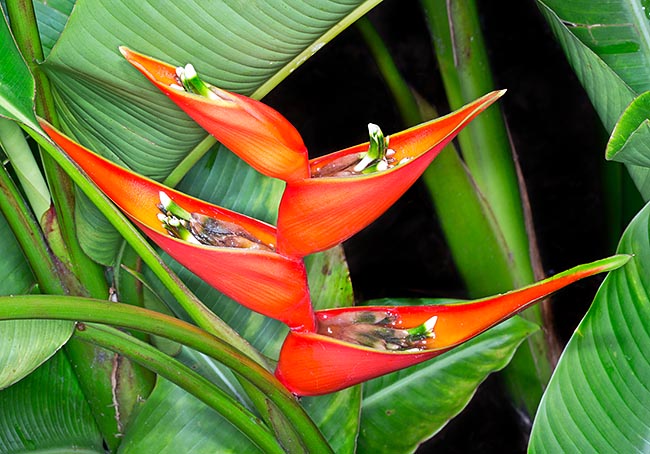Family : Heliconiaceae

Text © Pietro Puccio

English translation by Mario Beltramini
Heliconia stricta big leaves are used to wrap food and for steam cooking © Giuseppe Mazza
The species is native to Bolivia, Brazil (Acre, Amazonas, Amapá, Pará, Roraima, Rondônia and Tocantins), Colombia, Ecuador, Guyana, Peru, Surinam and Venezuela, where it grows in the humid forests at low and medium altitudes.
The name of the genus comes from the Latin “Heliconius, a, um” = of the Helicon, mountain sacred to Apollo and to the Muses; the name of the species is the Latin adjective “strictus, a, um” = narrow, compact, with reference to the inflorescence.
Common names: red lobster claw, small lobster claw (English); caetê-sanguíneo (Portuguese-Brazil); platanillo (Spanish).
The Heliconia stricta Huber (1906) is an evergreen, perennial rhizomatous erect herbaceous species forming 1,5-3 m tall dense tufts.
The leaves, on a 25-90 cm long petiole, are basal, alternate, distichous, simple, entire, ovate to obovate with pointed apex and usually reddish central nervation, prominent in the lower page, 0,45-1,5 m long and 20-30 cm broad, and sheathing tubular foliar bases forming a 40-70 cm long pseudo-stem.
The inflorescence is a 20-40 cm long, sessile erect terminal spike, with glabrous reddish rachis and 5-9 close bracts, distichous, coriaceous, with pointed apex, 15-25 cm long at the base, progressively decreasing upward, of red colour with thin green yellowish border, where water and debris attracting birds and small animals do collect.
The bracts subtend 15-22 flowers, on a white, 0,5 cm long pedicel, tubular, sigmoid, about 5 cm long, white at the base, intense green in the median part and white at the apex, opening in succession. The flowers, with bilateral symmetry, are hermaphroditic, with 3 sepals, two of which merged and one free, and three petals fused together, little differentiated between them, 5 fertile stamina and one white staminode, opposite to the free sepal; the flowers are pollinated by the hummingbirds. The fruits are dark blue globose drupes, containing 1-3 seeds. It reproduces by seed, previously scarified and kept in water for 3 days to soften the tegument, in organic loam with addition of siliceous sand or agri-perlite for a 30%, maintained humid at the temperature of 26-28 °C, with germination times variable from some months to one year, but usually and easily by division of the rhizomes in spring, with each section provided with several vegetative buds.
Species of great ornamental and landscape value thanks to its luxuriant foliage and the spectacular inflorescences, of which have been selected several varieties of different tonality of colour and also of reduced dimensions, less than one metre (the most cultivated is known as ‘Dwarf Jamaican’) cultivable in the humid tropical and subtropical climate regions in full sun or slight shade.

The 20-40 cm vertical inflorescence has 5-9 close bracts of 15-25 cm with 15-22 flowers © Giuseppe Mazza
It requires soils rich of organic substance, acidic or neutral, well draining, maintained almost constantly humid, but without stagnations, and a position sheltered from the wind; in zones with prolonged dry periods, is to be frequently watered, in particular during the warmest months.
Cultivable also in pot, in particular the contained size varieties, utilizing an organic substratum particularly draining and aerated, for the decoration of patios and balconies or for being sheltered in greenhouses, verandas and luminous winter gardens, where the climate does not allow the permanence in open air during the winter months, with high values of ambient humidity and of day temperatures, ideal 24-26 °C, with lowest night not under the 15 °C.
Watering must be regular and abundant in summer, leaving the substratum to partially dry up before giving water again, avoiding the stagnations, cause of easy rottenness, more spaced in winter, but without allowing the substratum to dry up completely, and the fertilizations done preferably with slow-release balanced products with addition of microelements. It is easily subject to attacks of mites and mealy bugs, to be treated, in case of serious infestation, with specific products.
The long-lasting, about 12 days, cut inflorescences are particularly appreciated in the floral compositions. The leaves are used by the local populations for wrapping and carrying food and for steam cooking.
Synonyms: Heliconia biahij Vell. (1827); Heliconia aureo-striata Bull. (1881); Bihaia bourgeauana Kuntze (1891); Bihai stricta (Huber) Griggs (1915); Heliconia tricolor Abalo & G.Morales (1985).
